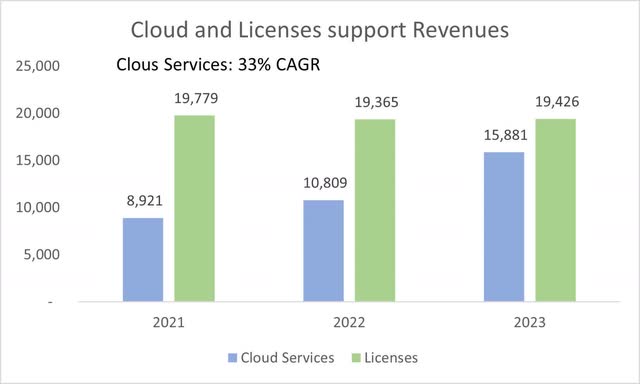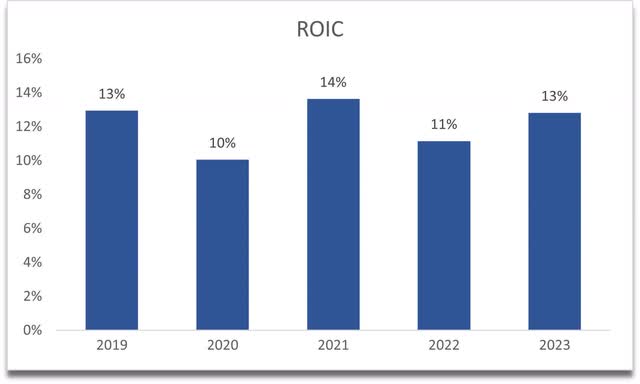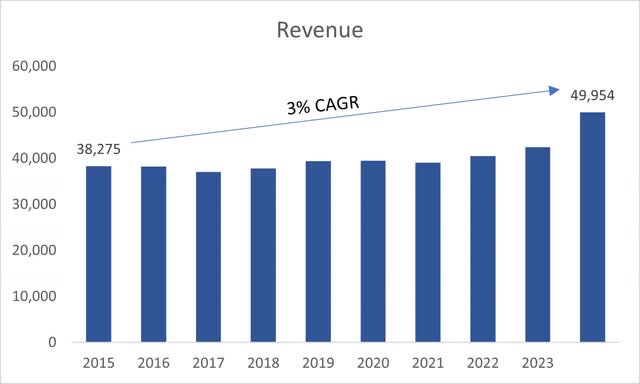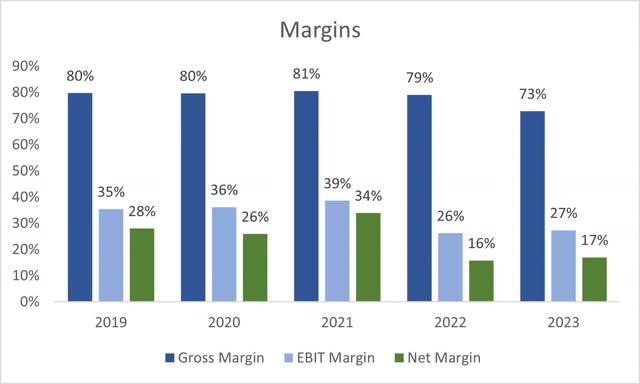Investment Thesis
I wanted to take a look at Oracle’s (NYSE:ORCL) financial situation and found that the company is becoming completely different, with accelerating revenue growth projected and a very rosy outlook in terms of cloud transformation efforts. The company’s financials are decent, but a large amount of debt may deter many investors, however, given reasonable and conservative assumptions, the company is trading at a discount to its fair value and would be a decent time to start a position if you don’t mind the macroeconomic risks and you believe that there is enough growth for ORCL in the dominated space of cloud infrastructure by three big players.
Comments on the Outlook
Oracle’s involvement within the Cloud service business will be the key to going beyond what the company managed to do in the last decade, where there was little to no growth. It is very hard to compete with the likes of Microsoft’s (MSFT) Azure, Amazon’s (AMZN) AWS, or Alphabet’s (GOOGL) Google Cloud. These three major players are holding the top three spots with AWS leading by a wide margin against Azure. That doesn’t mean that a company like Oracle cannot gain market share or be profitable in the same sector as these juggernauts.
Over the last few years, the company’s cloud and license support revenue segment has been performing impressively. When we dig into it a little deeper, we can see that the revenues from Cloud services were the main driver of this growth, while license support has been stagnant. The demand for cloud infrastructure and services has helped the company achieve a 33% CAGR over the last 3 years, which looks like a different company when we look at the company’s historical revenue growth, which will be covered in the next section.

Cloud and Licensing revenues. Cloud is on the way to overtake licensing (Author)
The management has been talking about acceleration of revenue growth for a while now and we can clearly see this unfolding over the last few years where the cloud is leading the way. With the demand far exceeding the supply of the cloud infrastructure, the company is going to benefit from the continuing shift to the cloud for many years to come, and with a projected 17.5% CAGR of cloud through 2030, I’m sure the company is going to capture some of that growth if the above cloud revenue growth is any indication of that. Furthermore, the recent partnership with Microsoft is going to boost both parties in the cloud race, more so for ORCL than MSFT. This partnership will help their customers accelerate the migration to the cloud and become much more efficient in their operations.
The recent acquisition of Cerner has boosted the company’s Services revenue segment significantly. Services are becoming a decent revenue generator. The acquisition will allow the company to enter a new market and it is aiming to improve the healthcare segment. With the acquisition, ORCL sees a huge opportunity in this segment and will be working hard on modernizing Cerner’s infrastructure and accelerating its digital transformation as well. This will take some time and there may be some inefficiencies at the start, however, once everything is transformed, the services segment is going to be a fantastic revenue growth engine for the company.

Services revenue (ORCL 10-K)
Financials
As of Q1 ’24 reported in September, the company had around $12B in cash and short-term investments, against a whopping $84.4B in long-term debt. Many investors dismiss companies with massive amounts of debt on the books, however, how worrisome is this debt for ORCL? At the end of FY23, the company’s interest coverage ratio stood at around 3.7x, which meant that EBIT was able to cover annual interest expense on debt around 4 times over. As of the latest quarter, the ratio was the same. Is this a good ratio? According to many analysts, an interest coverage ratio of 2x is considered healthy, but I’d like to be on the safer side, so I consider anything over 5x to be sufficient, but the fact that it has a decent pile of cash and well above 2, I would consider the debt not too risky at this point, especially that most of it is made up of fixed-rate loans, while a small portion is made up of variable rates, which are quite larger than the fixed ones at this point. Nevertheless, the average interest rate the company is paying on its debt is around 4%, which is fine.
ORCL’s current ratio has fallen under 1 in recent years due to the company’s cash reserves coming down considerably since FY22, which can be attributed to the company’s acquisition of Cerner, which amounted to around $28B. I don’t think this is going to be a permanent change in the company’s liquidity, and I believe that it will be able to regain its liquidity footing over the next couple of years, especially since the company has around $8B in deferred revenues, which is revenue that has not been earned yet because it is a subscription-based revenue.

Current Ratio (Author)
Looking at the company’s profitability and efficiency, ROA has seen better days in the past but has recovered slightly once the bottom line improved y/y in FY23. I’m looking for over 5% on Return on assets and the company just past that this year once again, so if the company continues to see improvements in sales and continues to pass down efficiencies to the bottom line, I could see this improving much more in the future. According to my model, I wouldn’t be surprised if we saw around 10% ROA in the near future.

ROA (Seeking Alpha)
Looking at the company’s return on invested capital, we can see that as of FY23, the company saw some improvements. It seems that the company is regaining its competitive edge, which is not easy to do given the company’s competition in the space. What is also good to see is that the company is creating value because its weighted average cost of capital, or WACC, is around 8%, which is much lower than ROIC.

ROIC (Author)
In terms of revenues, I am a little disappointed at the lack of growth the company has experienced over the last decade. The company did see a decent jump in revenues from FY22 to FY23, which can be attributed to the acquisition of Cerner. Will the company be able to sustain such growth going forward? The growth numbers will be better than what the company managed to attain in the last decade given the comments of Safra Catz, the CEO of the company, where in the latest earnings call, she said she expects the cloud revenue to grow 27%-29% in the second quarter of the year, which is quite an acceleration and will play a big role in the company’s future revenue generation as Cloud segment makes up around 45% of total revenues of the cloud and licensing segment. With such growth, I will not be surprised if Cloud takes over while licensing remains stagnant.

Revenue (Author)
The company’s margins saw a slight hit over the last couple of years, however, as of the latest quarter, the bottom line saw an improvement of around 200bps y/y, while operating margins remained relatively stable. Gross margins have gotten slightly lower y/y too, which is not a good sign, however, I tend to take quarterly reports with a grain of salt since these do tend to fluctuate a lot more due to cyclicality. I’ll have to wait for full-year results to see how margins developed.

Margins (Author)
Overall, it looks like I cannot judge the company by its historical performance, since the company has made some interesting acquisitions recently like Cerner, which helped boost the company’s sales considerably and the digital transformation efforts are looking to pay off very soon with much higher than anticipated revenue growth going forward of the cloud segment. I would like to see margins return to where they were a few years ago and I believe it will be able to, but for now, I will add a larger margin of safety because it is still uncertain.
Valuation
So, it looks like the company’s past performance in terms of sales is not a good indication for the future, especially with how the outlook is looking for Cloud services and coupled with the company’s fiscal ’26 sales projections of around $65B, I would have to assume the company is going to perform much better than it did in the past. For the valuation model, I went with 3 scenarios that are reasonable and conservative at the same time to give me an extra margin of safety. Below are my revenue projections for the base, optimistic, and conservative cases.

Revenue Assumptions (Author)
In terms of margins and EPS, the company will see improvements over time but only to the margin it saw a year or two ago, so it is not an improvement, and it is an expected one. The management is looking to improve the numbers across the board as they mentioned in the latest earnings report, so I feel confident in my conservative estimations.

Margins and EBIT Assumptions (Author)
As you can see my model isn’t too far off from the analysts’ estimates below. It is always easier to estimate a year or two out because of the management’s guidance, however, after those years, we need to make some educated guesses and assume what a likely outcome will be.

Analysts’ Estimates (Seeking Alpha)
For the model, I also used the mentioned company’s WACC of around 8% and terminal growth rate of around 2.5%, which is the targeted inflation rate of the US in the long run. On top of these assumptions, I decided to also add a 15% margin of safety to the final calculation for that extra bit of cushion. With that said, Oracle’s intrinsic value is $111.04 a share, implying the company is trading at a discount to its fair value.

Intrinsic Value (Author)
Risks
The biggest risks that come to mind are related to the competition in their cloud segment. As I mentioned earlier, the big three cloud players are taking up most of the demand for digital transformation. This may mean that the company’s revenue potential is limited, especially if the company is not able to offer something unique and add value to potential clients.
Another major risk I see is if the company drops the ball on technological innovation, while the big players, with their big pockets, are throwing money into the new cloud innovations that far exceed Oracle’s, which will lead to loss of customers and therefore loss of revenues. So far, this doesn’t seem to be happening and more partnerships like the one with MSFT will help the company stay relevant in the cloud business.
A lot of investors do not like debt, which means that the share price may never reach its potential because of a lot of risk-averse people. I don’t blame them, especially if the company may have a couple of bad quarters in the future with a debt outstanding that they’re not able to pay the annual interest expense then the company may have to do something drastic like cutting the dividend or getting rid of it completely (which is not that big anyway). I would like to see the company working on the outstanding debt, which may entice more investors.
In terms of macroeconomic risks, we are still seeing a lot of shakiness in the markets due to the sticky inflation and the economy running very hot, which may mean higher interest rates for longer. I wouldn’t be surprised if we see further downside in the share price over the next few months. I would take that as a good entry point for a long-term investment as I believe the upside outweighs the risks.
Closing Comments
It looks like it is not a bad time to start a position at these levels as risk/reward seems to be quite enticing. I think there are two choices to make here. One is to start a position right now (a small one) and slowly build it up. Another one, which is my preference, if you have the capital to own 100 shares of the company, is to sell cash-secured puts at a lower strike price than the current share price. That way if you are happy at owning the stock at this price, you will be even happier at a lower price, and also get paid while the share price comes to you.
Either way, it seems the company is trading at a discount to its fair value, and I wouldn’t be surprised if it continues to perform well in the future as the potential in the cloud AI space seems to be immense and the company looks very different from its former self just a couple of years ago.
It may not be as big as the three major players in cloud space but that doesn’t mean that it is not going to make you money in the long run.
Read the full article here



